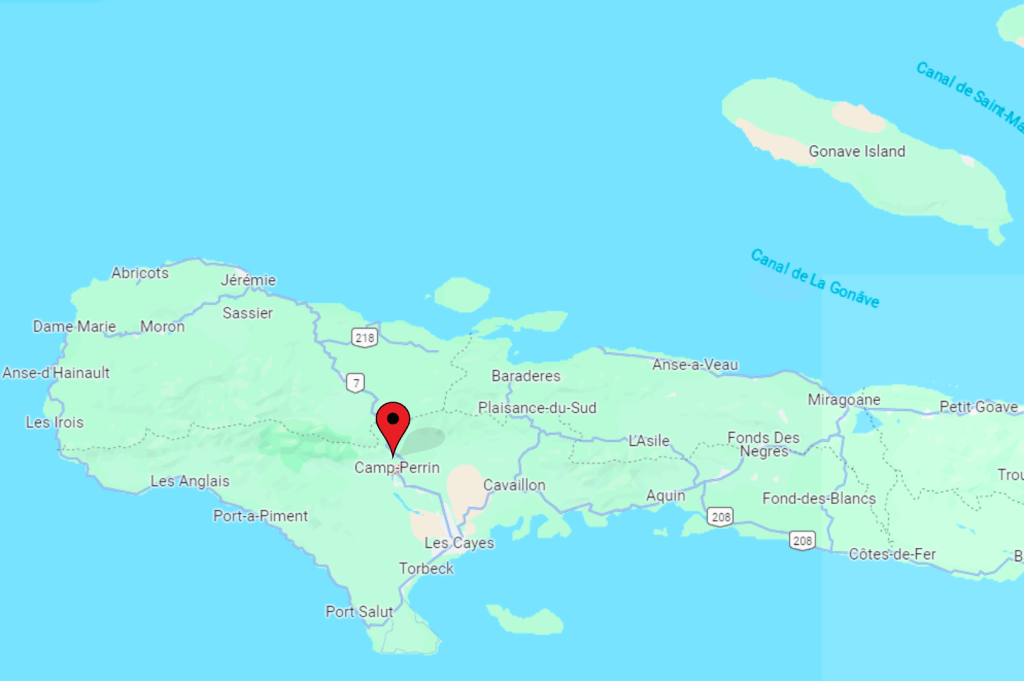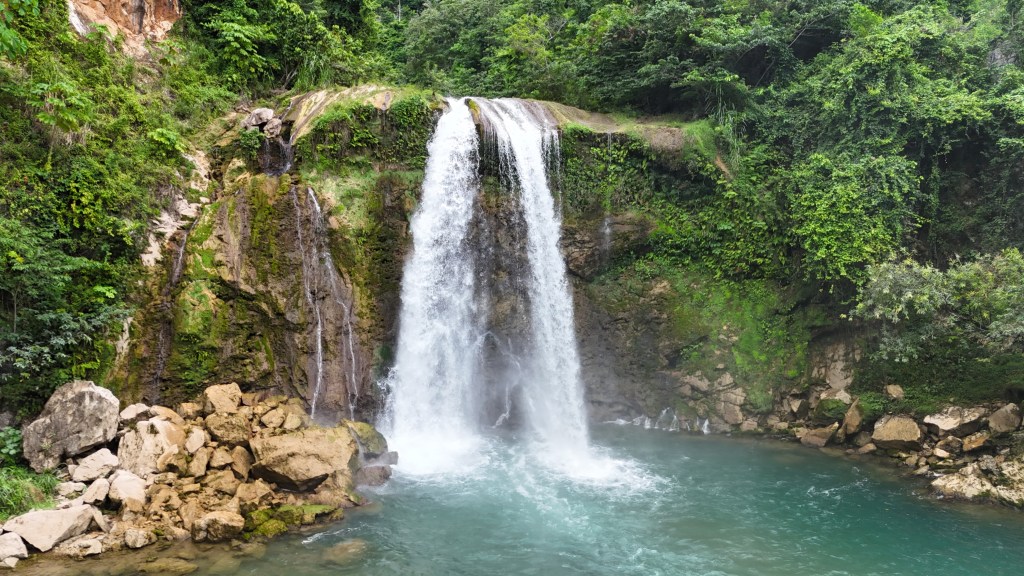Listeners:
Top listeners:
-
 play_arrow
play_arrow
RADIO DROMAGE
 Bloc Party - Helicopter
Nothing much really
Lucy Harty
Bloc Party - Helicopter
Nothing much really
Lucy Harty
 Chase Rice - Ready Set Roll
Are we on air???
Roy Yellow
Chase Rice - Ready Set Roll
Are we on air???
Roy Yellow
 Annoying Orange - Party Rock
You know I come to party hard!!
Annoying Orange - Party Rock
You know I come to party hard!!


PORT-AU-PRINCE— Peaceful Camp-Perrin, Haïti’s southern city located just a few miles road from Antoine Simon Les Cayes Airport — following a short flight out of Port-au-Prince, is emerging as one of the country’s premier destinations for local visitors and foreigners alike. Nestled approximately 14 miles southwest of Les Cayes, the main city of the South Department, and about 138 miles of Port-au-Prince, this charming town boasts significant natural attractions, with the Mathurine jump and the Kounoubwa cave, also known as Saut Mathurine and Gwòt Konoubwa respectively, standing out as prominent landmarks.

Situated on the right bank of the Ravine du Sud river, Camp-Perrin is a remarkably clean and hospitable town designed to captivate visitors. Over the past decade, leisure activities have flourished here, attracting more tourists despite the remote location. The town can be accessed from Port-au-Prince by road or a short 25-minute flight from Toussaint Louverture International Airport. With its unique charm and growing appeal, Camp-Perrin is one of the top destinations in Haiti’s South Department.
The Kounoubwa cave and the Mathurine jump are very visited. With these two sites, this city welcomes thousands of visitors from all over Haiti and the world, notably travelers from North America, Europe and the Caribbean.

The Kounoubwa Cave
The Kounoubwa cave, discovered over 70 years ago, has key attractions to draw visitors from all over Haiti and beyond. As the second largest cave in the region after the Marie-Jeanne cave located in the commune of Port-à-Piment, Koukounoubwa holds significant historical and cultural value. It represents an inestimable asset and a pillar for any development program wishing to highlight the tourist potential of the South department, many argue.
The site is positioned amidst a picturesque mini-forest, enhancing its natural allure. The cave entrance, though challenging to access because it is very slippery, opens into a world of coral-like cylindrical or conical forms, which are deposits of mineral, sculpted by the steady flow of water. The beauty of these formations is extraordinary. Inside, visitors can explore at least twenty-four caverns.
“The cave is the ideal place for devotees of a spirit known as Grandbois, the master of the place, to enter into a trance.”
Joël Constant, Local Guide
The different forms, sculpted by the flowing water, spark the imagination of visitors and guides alike. Some formations have been named whimsically “ The Cathedral, “The Statue of Saint Christopher”, and feature figures ressemnling shapes of snakes, horses and many other animals.
The cave is so extraordinary that the flowing water sculpts several images, sparking the imagination of visitors and guides alike.
A notable figure in the cave is a large stone named “Master Crossroads” attributed to the exit. The site is a melting pot of cultural rituals serving as both a place of entertainment and spiritual significance. Christians praise the greatness of their God and Vodouists consider it a pilmigrage site.
According to Joël Constant, a local guide, vodou ceremonies are regularly held in the Kanoubwa cave.
“It is the ideal place for devotees of a spirit known as Gran Bwa [ Creole for The Great Tree], the master of the place, to enter into a trance,” Constant said.
The Mathurine jump

The 27-meter Saut Mathurine waterfall, one of the country’s largest and most beautiful waterfalls, serves as an iconic image of the region. This is the undisputed Camp-Perrin label. Extending over the Cavaillon river in the heights of Camp-Perrin, the waterfall is the town’s main tourist attraction. Whether young or old, men or women, no visit is complete without taking a few hours soaking in Saut Mathurine.

The history of Camp-Perrin

Beyond this natural wonders, Camp-Perrin has much more to offer than the renowned waterfall. The town has several extraordinary attractions, such as the natural swimming pool fed by the South Ravine river and located in an area called Bananier. This spot remains a favorite summer destination for local youths and visitors alike looking for a place deep in freshwater.
With a rich history dated back to the 13th century, the town —formerly named Perrin— has evolved into a hub for cultural, educational and agricultural activities. Named after three brothers, who arrived there from France in the 1700s to exploit coffee, cotton, indigo and campeche wood, it served once as a holiday resort, a natural site and an ecological monument. Camp-Perrin was elevated from a rural section of Les Cayes to the rank of commune in 1930.
During the French colonial era, it was a preferred retreat for southern planters who gathered there for leisure and vacation. The town is home to notable site such as the Avezac canal, the Lévy School workshop; Saint-Anne Church; the Levy agricultural farm; the Germplasm center and the Petit Séminaire-Collège de Mazenod, a school established since 1945.
The post Haiti’s Camp-Perrin a hidden treasure to discover appeared first on The Haitian Times.
Haiti’s Camp-Perrin a hidden treasure to discover was first posted on August 1, 2024 at 1:42 pm.
Écrit par: Viewcom04
Articles similaires
Articles récents
- En Haïti, ils transforment les déchets plastiques en objets utiles
- La CSCCA fixe au 31 décembre 2025 la date butoir pour la soumission des contrats publics
- À la Sorbonne, le Recteur de l’UEH relance le combat pour la restitution et la réparation de la dette de 1825
- La bataille silencieuse de la Russie contre le déclin de sa population
- FIFA The Best 2025 : Melchie Dumornay soutenue par le Brésil et la République dominicaine, qui l’ont classée numéro un
Commentaires récents
Aucun commentaire à afficher.-

Réveil Spirituel
Avec ZRECK NORELIA
For every Show page the timetable is auomatically generated from the schedule, and you can set automatic carousels of Podcasts, Articles and Charts by simply choosing a category. Curabitur id lacus felis. Sed justo mauris, auctor eget tellus nec, pellentesque varius mauris. Sed eu congue nulla, et tincidunt justo. Aliquam semper faucibus odio id varius. Suspendisse varius laoreet sodales.
close Chart
-
1
play_arrowYo Dim Sa
K-Dans
-
2
play_arrowBiznis Pam
Djakout #1
-
3
play_arrowJere'm
Harmonik
-
Top popular

Le gouvernement haïtien définit ses priorités pour le prochain budget
Processus électoral : le COSHARCO et la CSH accusés de favoritisme
Flashback | Bombardopolis-Haïti, terre d’accueil pour Johannes Drumpft, l’arrière-grand-père de Donald Trump
Pafwa

Haiti’s Fort Jacques, once a great attraction to visitors, is now abandoned as gang-fueled insecurity keeps tourists away




